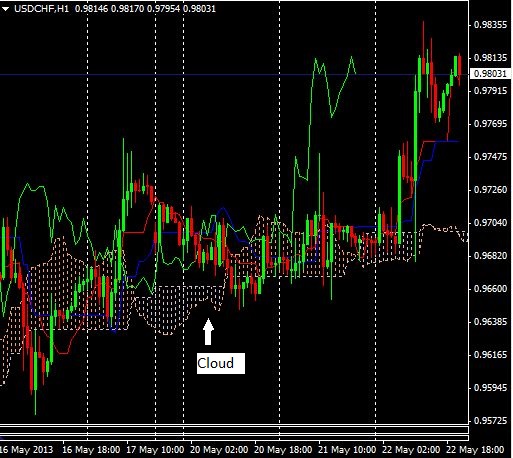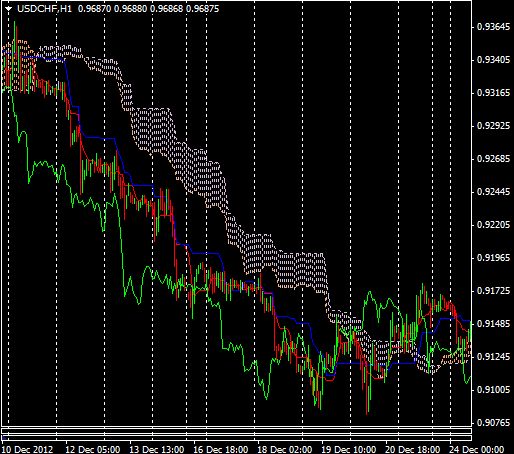Ichimoku Indicator – Giving a Clear Picture
Price is the ultimate indicator, as it’s the only thing upon which your profits are determined. Yet many traders like to use indicators. While indicators are only manipulations of price data, they can provide you with insight that you may not be seeing in the price movement itself. For those who like indicators, the Ichimoku Kinko Hyu or “Ichimoku cloud” is an indicator that deserves a bit of study. There are many ways to use the indicator, but one way stands out in my mind. The Ichimoku indicator is a visual way to trade, and can very quickly give you a snapshot of the health of a trend, whether a trade is worth taking or if a trend is reversing.
Ichimoku Indicator
At first this indicator can be a little overwhelming, and adding it to your chart will clutter things up a bit. Fear not though, as this will likely be one of the only overlay indicators you need, and for the most part I only focus one major aspect of the indicator–the cloud. More on that shortly.
Add the indicator in a charting platform and you’ll be asked to input some default values for the indicator. Here are the default values for the various lines:
Tenkan-Sen (Conversion Line): 9 Periods
Kijun-Sen (Base Line): 26 Periods
Senkou Span A: This isn’t usually asked for as it’s the mid-point of the Conversion and Base line.
Senkou Span B: 52 Periods
Chikou Span (Lagging Span): 26 Periods
Once you are familiar with the indicator, and are using it effectively you may find adjusting the values slightly helps with your particular time frame, strategy or market.
After inputting the values, you’ll see something like Figure 1.
Figure 1. USD/CHF – 1 Hour Chart with Ichimoku Kinko Hyo

Source: MetaTrader
A little confusing, but remember, when first learning this indicator you only need to concern yourself with the “cloud.” The cloud is the dotted white lines that move along with the price, as indicated on the chart.
Ichimoku Cloud Interpretation
By focusing just on the cloud, you can quickly extract a lot of information from a price chart. The cloud can be used to confirm trend, indicate reversals, determine strength or weakness as well as give you “no trade zones.” Here is how the cloud does each of these things.
Confirming Trends: Similar to a simple moving average, when the price is trading above the cloud this typically signals that the asset is in an uptrend. When the price is trading below the cloud this typically indicates the asset is in a downtrend, as shown in Figure 2.
Figure 2. USD/CHF – 1 Hour Ichimoku Downtrend

Indicating Reversals: Strong uptrends or downtrends usually stay above or below the cloud respectively. Pullbacks (moves against the trend) will often “bounce” off of the cloud or penetrate it slightly but then resume the trend direction. If the price moves fully through the cloud it indicates a reversal of the trend is potentially underway.
Determine Strength and Weakness: The thicker the cloud typically the harder it will be to pierce. On the other hand, if the cloud is very thin it indicates indecision and that the trend losing a bit of steam. A thin cloud does not indicate a reversal though; it simply is showing that the trend doesn’t have as much momentum currently, relative to prior price action.
Using “No Trade” Zones: Since we are using the cloud to help isolate trends, reversals and strength/weakness, establishing a no trade zone helps to clear up any conflicting signals which may arise. When the price enters the cloud, don’t take new positions. Wait to see what happens; either the former trend will continue and you can trade with it, or the price will move right through the cloud indicating there may be a reversal trade.
Putting it Together
Ultimately, the best strategies are the ones that align your trades with the trend. The cloud helps you see the trend so you can trade with it. If the trend is up, you want to buy (calls) when the price drops toward the cloud but then begins to bounce off of it, moving higher once again. If the trend is down, you want to short (buy puts) when the price rallies toward the cloud, bounces off it and starts moving lower again. When the price enters the cloud, hold off on making a trade until the price starts trading either above or below the cloud, and then use the strategy mentioned above. This approach allows for a lot of information to be quickly absorbed, allowing you to decide if a potential trade is possible or if it’s better to wait. While all indicators have their weaknesses, and losing trades will always occur, Ichimoku is good for traders who like the visual nature of indicators and are looking for a quick way to assess trades.